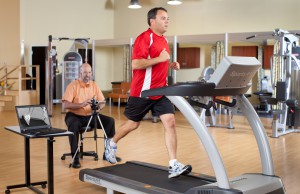Shock – Injury – Cadence – Quiet
 This blog was written by Damien Howell, PT, DPT, OCS.
This blog was written by Damien Howell, PT, DPT, OCS.
How hard a walker or runner impacts the ground can be described with several different bio-mechanical terms, including vertical impact loading rate, braking impulse force, or shock. Scientists have determined that it is not the magnitude of force, but rather the rate at which the force is transmitted from the ground to the foot and leg that is the critical factor related to the development of repetitive-use injuries. The magnitude of the force is a function of how much you weigh. Whether you weigh a lot or weight very little is not the issue, but rather how quickly your body weight strikes the ground.
Some walkers and runners have larger impact forces and research is developing showing that they are at increased risk for developing stress fractures and tendon injuries. The current thinking reflects the way or manner in which an individual walks or runs is thought to explain why some individuals have larger vertical impact forces.
Until recently, the research correlating large impact forces with development of injuries was retrospective. Runners who were already injured were examined. A 2016 publication by Irene Davis, a Physical Therapist at Spaulding National Running Center, reported a prospective study of 249 runners. They measured runners who had never been injured, as well as runners who had previous injury and found that runners who land “hard” have higher impact forces and increased risk for injuries. Runners who have never been injured had the lowest impact loading.
Years ago, when I was running in several local marathons, there was a runner who raced the same pace that I was running. He was a noisy runner and the loud sound of his feet striking the ground was irritating. I would try to speed up to get away from the annoying stomping and he would speed up and keep pace with me. I never actually introduced myself to the stomping runner, so I don’t know if he had stress fractures, but the manner in which he ran suggested that he was someone who runs with higher vertical impact forces. At the time, I thought it was odd as this stomping runner must have been 60 pounds lighter than me. I can now recognize that it is not how heavy you are, but how sudden or quickly you strike the ground that makes the sound and impact.
Around the same time when running the New York marathon, I remember Grete Waits came running by me at mile 20 and it felt like she was a “whispering jet” quietly blowing by me. I did not hear her approach; I just felt the breeze as she blew by me. She went on to win the New York Marathon in record time. This is someone whom I would think has very low vertical impact forces when running.
How do you determine whether you walk or run with relatively high impact loading rate? The standard method of measuring shock requires a sophisticated instrumented three-dimensional motion analysis lab with force plates imbedded in the ground or treadmill.
In the last few years with the advancement of wearable devices, wireless tri-axial accelerometers that indirectly measure shock when walking and running have become available. There are now applications for your smart phone which function like an accelerometer.
There is a growing body of evidence showing that an individual can alter the manner in which they walk and run with training. Chris Napier from U of British Columbia reviewed literature (27 studies) and concluded the most effective way for “gait training” involved real time visual and/or audio feedback. If you are interested in changing the manner in which you walk or run to decrease shock, the next question is to address is how would one accomplish this?
There are multiple factors involved in the complex movement of running and walking. There are likely multiple options available to change the manner in which you run and walk. Following the concept of “keep it simple stupid”, there are two effective methods: cadence training and to run quietly.
When walking, the foot is in contact with the ground for less than a half second, and when running the foot is in contact with the ground for much less than a half second. The impact phase occurs in the first 20% of the time that foot is in contact with the ground. Therefore, there is very little time – milliseconds – available to spread the impact forces to lessen the shock transmitted to the feet and legs.
One strategy of gait training that will decrease shock is cadence training. Brian Heiderstacheit a Physical Therapist at University of Wisconsin has shown for a given speed, a conscious effort to take shorter steps and more steps per minute results in a reduction of impact loading. If the speed of walking or running is held constant and the individual uses the auditory feedback of the sound from a metronome to increase the preferred cadence for a particular speed to a relatively faster cadence by a factor of 5%, this effectively shortens the stride or step length. If the stride length is shortened, the vertical oscillation of the center of mass (the up and down movement of the body) is decreased, and this results in a decrease in vertical impact loading rate. Some runners look like they are bobbing up and down or hoping down the road, and this manner of running results in relatively greater vertical impact loading rate. A verbal cue of dampening your up and down motion when walking or running can decrease vertical impact loading rate. An alternative verbal cue is to take short steps, more steps per minute.
Investigators from East Carolina University (Richard Willy 2015) have taken this concept to the real world on the road. Using wearable accelerometers to provide real-time cadence feedback resulted in significant decreases in impact forces at the knee.
An alternative strategy to cadence training is listening to the sound of your foot striking ground. Research by Kevin Wernli Curtin University Australia has shown that the sound of the foot impacting the ground is directly related to the rate of impact loading. The louder the sound of the foot striking the ground, the higher the shock is. I describe this strategy as a poor man’s force plate or accelerometer. Listen to the sound that your foot makes when hitting a treadmill or the road and then try to land quieter to decrease the risk of injury. This is another argument to not run with head phones or ear phones. The cueing description I use now is to “run like you are trying to sneak up on someone”. Run soft and quietly.
As a routine now when I do a slow motion video analysis of walking or running form, I listen to the sound of feet striking the surface. When presented with a repetitive-use injury that is on one side of the body, often there is an asymmetry in the sound of the foot striking. One foot makes a louder sound. Using the work of Wernli we can assume that one side of the body is experiencing more shock than the other. Hearing asymmetry is a clue, but is not the answer as to what is wrong. The side with the louder sound can be the injured, weaker side. The sound with the louder sound can be the uninjured, stronger side. Currently, there is no easy rule to determine the treatment. It requires a clinical problem-solving approach to determine whether the cueing should be to make the quieter side louder or the louder side quieter, or both.
Take shorter steps, more steps per minute, and be quiet.
